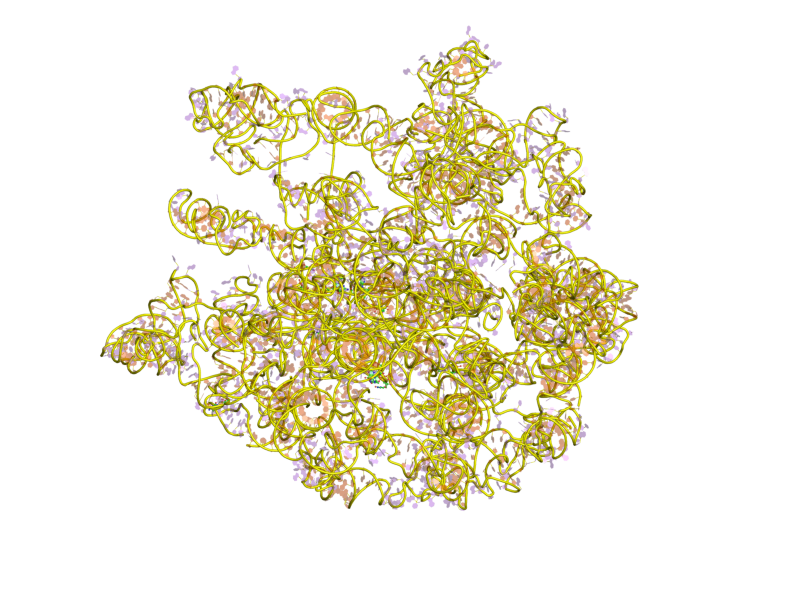23S on:
[Wikipedia]
[Google]
[Amazon]
 The 23S
The 23S
Pseudobase entry for pseudoknot of the 23S ribosomal RNA (PKB00148)
{{Ribosome subunits Ribosomal RNA
 The 23S
The 23S rRNA
Ribosomal ribonucleic acid (rRNA) is a type of non-coding RNA which is the primary component of ribosomes, essential to all cells. rRNA is a ribozyme which carries out protein synthesis in ribosomes. Ribosomal RNA is transcribed from ribosomal ...
is a 2,904 nucleotide
Nucleotides are Organic compound, organic molecules composed of a nitrogenous base, a pentose sugar and a phosphate. They serve as monomeric units of the nucleic acid polymers – deoxyribonucleic acid (DNA) and ribonucleic acid (RNA), both o ...
long (in ''E. coli
''Escherichia coli'' ( )Wells, J. C. (2000) Longman Pronunciation Dictionary. Harlow ngland Pearson Education Ltd. is a gram-negative, facultative anaerobic, rod-shaped, coliform bacterium of the genus ''Escherichia'' that is commonly foun ...
'') component of the large subunit (50S
50 S is the larger subunit of the 70S ribosome of prokaryotes, i.e. bacteria and archaea. It is the site of inhibition for antibiotics such as macrolides, chloramphenicol, clindamycin, and the pleuromutilins. It includes the 5S ribosom ...
) of the bacterial/archean ribosome and makes up the peptidyl transferase center (PTC). The 23S rRNA is divided into six secondary structural domains titled I-VI, with the corresponding 5S rRNA being considered domain VII. The ribosomal peptidyl transferase
The peptidyl transferase center (, PTC) is an Aminoacyltransferases, aminoacyltransferase ribozyme (RNA enzyme) located in the large subunit of the ribosome. It forms peptide bonds between adjacent amino acids during the Translation (genetics), ...
activity resides in domain V of this rRNA, which is also the most common binding site for antibiotics that inhibit translation, making it a target for ribosomal engineering. A well-known member of this antibiotic class, chloramphenicol
Chloramphenicol is an antibiotic useful for the treatment of a number of bacterial infections. This includes use as an eye ointment to treat conjunctivitis. By mouth or by intravenous, injection into a vein, it is used to treat meningitis, pl ...
, acts by inhibiting peptide bond formation, with recent 3D-structural studies showing two different binding sites depending on the species of ribosome. Numerous mutations in domains of the 23S rRNA with Peptidyl transferase activity have resulted in antibiotic resistance
Antimicrobial resistance (AMR or AR) occurs when microbes evolve mechanisms that protect them from antimicrobials, which are drugs used to treat infections. This resistance affects all classes of microbes, including bacteria (antibiotic resis ...
. 23S rRNA genes typically have higher sequence variations, including insertions and/or deletions, compared to other rRNAs.
The eukaryotic homolog of the 23S LSU rRNA
Large subunit ribosomal ribonucleic acid (LSU rRNA) is the largest of the two major RNA components of the ribosome
Ribosomes () are molecular machine, macromolecular machines, found within all cell (biology), cells, that perform Translation (b ...
is the 28S ribosomal RNA
28S ribosomal RNA is the structural ribosomal RNA (rRNA) for the large subunit (LSU) of eukaryotic cytoplasmic ribosomes, and thus one of the basic components of all eukaryotic cells. It has a size of 25S in plants and 28S in mammals, hence th ...
, with a region filled by the 5.8S ribosomal RNA.
23S rRNA Functions
In general, rRNA has an essential function of peptidyl transferase. The stimulating core of the ribosome plays role in the peptide bond configuration. Both peptidyl-tRNA and aminoacyl-tRNA are important for protein synthesis and transpeptidation response.Essential Bases
However, 23S rRNA positions (G2252, A2451, U2506, and U2585) have a significant function for tRNA binding in the P site of the large ribosomal subunit. These modification nucleotides in site P can inhibit peptidyl-tRNA from binding. U2555 modification can also intervene with transferring peptidyl-tRNA to puromycin. Furthermore, the chemical modification of half of these positions G2251, G2253, A2439, and U2584 can not prevent the tRNA binding. Peptidyl-tRNA of 50S subunits which binds to the P site preserve eight positions of 23S rRNA from chemical modification. On the other hand, mutation in 23S rRNA can also have impacts on cell growth. Mutations A1912G, A1919G and Ψ1917C have a powerful growth phenotypes and they prevent translation while mutation A1916G has a simple growth phenotype and it leads to defect in the 50S subunits.23S rRNA Helix 26a
The 23S ribosomal RNA is composed of six domains forming a complex network of molecular interactions. A central single-stranded region connects all of the domains through base-pairing of the two halves, forming Helix 26a. Some consider Helix 26a to be Domain 0 due to its action as a central core and compact folding unit. Comparison of 23S and 28S ribosomal RNA sequences across species demonstrate conservation of Helix 26a. Helices continue to provide the support as the backbone of domain architecture.Plastid
Chloroplast ribosomes from "higher" plants have an additional 4.5S rRNA created by fragmentation of 23S. It is located to the 3' side of 23S in therRNA operon
The ribosomal DNA (rDNA) consists of a group of ribosomal RNA encoding genes and related regulatory elements, and is widespread in similar configuration in all domains of life. The ribosomal DNA encodes the non-coding ribosomal RNA, integral struc ...
and corresponds to the 3' end of non-fragmented 23S rRNA.
See also
* 23S methyl RNA motif *LSU rRNA
Large subunit ribosomal ribonucleic acid (LSU rRNA) is the largest of the two major RNA components of the ribosome
Ribosomes () are molecular machine, macromolecular machines, found within all cell (biology), cells, that perform Translation (b ...
References
External links
*Pseudobase entry for pseudoknot of the 23S ribosomal RNA (PKB00148)
{{Ribosome subunits Ribosomal RNA